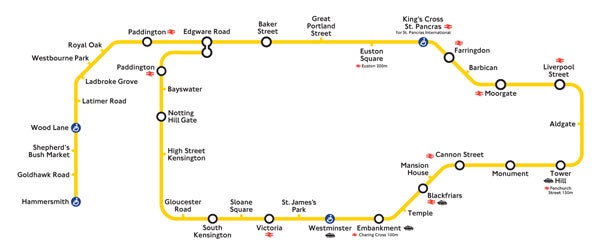Simon Calder: The Circle line - about to spiral out of control

Your support helps us to tell the story
From reproductive rights to climate change to Big Tech, The Independent is on the ground when the story is developing. Whether it's investigating the financials of Elon Musk's pro-Trump PAC or producing our latest documentary, 'The A Word', which shines a light on the American women fighting for reproductive rights, we know how important it is to parse out the facts from the messaging.
At such a critical moment in US history, we need reporters on the ground. Your donation allows us to keep sending journalists to speak to both sides of the story.
The Independent is trusted by Americans across the entire political spectrum. And unlike many other quality news outlets, we choose not to lock Americans out of our reporting and analysis with paywalls. We believe quality journalism should be available to everyone, paid for by those who can afford it.
Your support makes all the difference.Travel certainties are rare, and mostly negative. Inadvertently sail your yacht into Iranian territorial waters, and you can be sure that the authorities will not point you in the right direction and bid you a cheery farewell. Turn up one minute late for your Ryanair flight, and the ground staff will not give you a knowing wink and usher you on board with a smile.
One outstanding positive certainty, though, has prevailed through your entire life: the London Underground's Circle Line.
Tilt Frank Pick's marvellous Underground map on its side, and the Circle Line comes into focus: it's the one shaped like a wine bottle. And, in the event that you have enjoyed a glass too many at a Christmas gathering, you can rely upon it to get you home: wherever you get on, and whichever direction you take it, you are sure eventually to end up at your chosen main-line terminus, be it Victoria, Paddington, King's Cross or Liverpool Street.
The Circle Line predated the M25 by more than a century in orbiting London. For the last 125 years, weary, inebriated or plain confused visitors to the city have been rescued by the Circle Line.
That familiar yellow line connects many of the capital's tourist attractions: the museums of South Kensington, Madame Tussaud's at Baker Street, and the Tower of London. But next weekend, chaos will replace order. "The new extended Circle Line" promises fewer delays. The problem is, it no longer forms a complete circle in the manner of Glasgow's Subway and the Moscow Metro line 5. Instead, it uses existing tracks in a curious spiral arrangement that catches up with itself at Edgware Road and then flies off at a tangent to Hammersmith. These termini will henceforth be known as the Stations of the Cross: they are the places where ill-tempered travellers discover that the term "Circle" was a fib, and are forced to find alternatives.
Marcel Proust, a man with some profound thoughts on discontinuities in life, said "We must never be afraid to go too far, for truth lies beyond". Tourists who find themselves waiting in W6 when they want to be at Westminster may disagree.
The Underground always involves a suspension of disbelief. Despite the name, most of the system runs above ground. The Tube map is a cartographic triumph, but it bears little relation to reality on the surface. You can demonstrate this by walking from Bond Street to Notting Hill Gate (about three miles), even though it looks the same distance as Borough to London Bridge (500 yards). The only thing "Central" about Epping and West Ruislip is the 34-mile thin red line that unites them. And which Tube line extends furthest south? The Northern Line.
Tourists can accept such fibs. But the change that takes effect on Sunday 13 December is a transformation too far. London will lose a great strength, and gain the most perversely shaped urban rail line on the planet.
Want to travel from the shops of High Street Kensington to the Eurostar terminus at St Pancras? Until next weekend, you can trundle eight stops in a clockwise direction. Thereafter you must choose between 19 stops counter-clockwise or an awkward change of trains at Edgware Road (where, to spice things up for foreign tourists, there are two separate stations, not to mention Edgware itself at the end of the Northern Line). And anyone arriving at Paddington station by main-line train or Heathrow Express hoping to go further west than one stop to Edgware Road needs to locate the distant and obscure platform 16, right at the end of a long walk and a crowded staircase.
Mind the gap, indeed
Sky-high fares for the Underground's 'helix to hell'
The new "Circle" line has been described as a "teacup" or a "tadpole". It looks to me like a helix to Hell (or Hammersmith). Whatever you call it, the line shares with the rest of London's Underground the unwelcome distinction of having the highest cash fare for any system in the world: £4, even if you only travel the 250 yards between Cannon Street and Mansion House.
Investing £3 as down-payment on an Oyster stored-value card is worthwhile even if you are only an occasional visitor; the fare shrinks to £1.60. This still compares unfavourably with Glasgow's still-circular Subway (a flat, fair £1.20). A trip of any length on the Moscow Metro costs 22 roubles (45p), while the longest possible journey on the Kolkata Metro is 8 rupees (10p).
Join our commenting forum
Join thought-provoking conversations, follow other Independent readers and see their replies
Comments